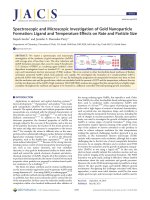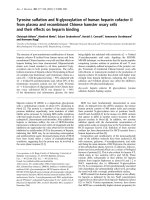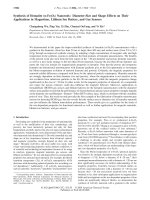residual stresses and their effects on fatigue resistance
Bạn đang xem bản rút gọn của tài liệu. Xem và tải ngay bản đầy đủ của tài liệu tại đây (1.37 MB, 48 trang )
Ali Fatemi-University of Toledo All Rights Reserved Chapter 8 – Residual Stresses & Their Effects
1
RESIDUAL STRESSES
AND THEIR EFFECTS ON
FATIGUE RESISTANCE
Ali Fatemi-University of Toledo All Rights Reserved Chapter 8 – Residual Stresses & Their Effects
2
RESIDUAL STRESSES AND THEIR EFFECTS ON
FATIGUE RESISTANCE
• To improve fatigue resistance we should try to avoid
tensile mean stress and have compressive mean stress.
This can often be achieved by using residual stresses
.
• Residual stresses are in equilibrium within a part,
without any external load.
• They are called residual stresses because they remain
from a previous operation.
• Residual stresses exist in most manufactured parts and
their potential to improve or ruin components subjected to
millions of load cycles can hardly be overestimated.
Ali Fatemi-University of Toledo All Rights Reserved Chapter 8 – Residual Stresses & Their Effects
3
RESIDUAL STRESSES AND THEIR EFFECTS
ON FATIGUE RESISTANCE
EXAMPLES
PRODUCTION OF RESIDUAL STRESSES & FATIGUE RESISTANCE
RELAXATION OF RESIDUAL STRESSES
MEASUREMENT OF RESIDUAL STRESSES
STRESS INTENSITY FACTORS FOR RESIDUAL STRESSES
SUMMARY AND DOS AND DON’TS IN DESIGN
Ali Fatemi-University of Toledo All Rights Reserved Chapter 8 – Residual Stresses & Their Effects
4
EXAMPLES
Ali Fatemi-University of Toledo All Rights Reserved Chapter 8 – Residual Stresses & Their Effects
5
S-N behavior of a Ni-Cr alloy steel
subjected to rotating bending
with three different surface
conditions involving
smooth (solid circles),
notched (x’s), and
notched shot-peened (open
squares) specimens.
With the notched shot-peened
specimens, the fatigue resistance
is essentially the same as the
smooth specimens. Thus, the
notch became perfectly harmless
after it was shot-peened due to
the desirable residual
compressive stresses.
Ali Fatemi-University of Toledo All Rights Reserved Chapter 8 – Residual Stresses & Their Effects
6
Effect of residual stresses produced by prestretching (tensile
overload) on fatigue strength and fatigue notch factor of specimens
of 4340 steel with two different notches and at two hardness levels.
The residual stresses eliminated the notch effect almost completely.
Note that with the residual stresses induced by stretching, the worst
notched specimens became much stronger than the best notched
specimens without residual stresses.
Ali Fatemi-University of Toledo All Rights Reserved Chapter 8 – Residual Stresses & Their Effects
7
PRODUCTION OF RESIDUAL
STRESSES & FATIGUE
RESISTANCE
Ali Fatemi-University of Toledo All Rights Reserved Chapter 8 – Residual Stresses & Their Effects
8
PRODUCTION OF RESIDUAL STRESSES &
FATIGUE RESISTANCE
The many methods of inducing residual stresses
in parts can be divided into four main groups:
Mechanical Methods
Thermal Methods
Plating
Machining
Ali Fatemi-University of Toledo All Rights Reserved Chapter 8 – Residual Stresses & Their Effects
9
MECHANICAL METHODS
Mechanical methods of inducing residual stresses:
Rely on applying external loads that produce localized inelastic
deformation.
Upon removing the external loading, elastic “springback” occurs
that produces both tensile and compressive residual stresses.
Both tensile and compressive residual stresses must be present in
order to satisfy all equations of internal force & moment
equilibrium, F = M =0.
Ali Fatemi-University of Toledo All Rights Reserved Chapter 8 – Residual Stresses & Their Effects
10
MECHANICAL METHODS
Figure 8.2 shows this process for
inelastic bending of a beam behaving
in an elastic-perfectly plastic manner.
Quantitative calculations are possible
(left as a homework problem).
The beam in Fig. 8.2c will have
better fatigue resistance at the
bottom fibers than at the top fibers.
Thus, straightening of parts by
bending is usually detrimental due to
the undesirable tensile residual
stresses that form in regions
overloaded in compression.
If the material were not elastic-
perfectly plastic, the residual stress
distribution in Fig. 8.2c would be
non-linear.
Ali Fatemi-University of Toledo All Rights Reserved Chapter 8 – Residual Stresses & Their Effects
11
MECHANICAL METHODS
Stretching (tensile overload) of the
notched specimen shown.
Again, the material is assumed to be
elastic-perfectly plastic.
Nonuniform tensile stress distribution
during the inelastic loading.
The summation of the inelastic
loading stresses and the elastic
unloading stresses result in the
residual stress distribution shown in
Fig. 8.3c.
Note that tensile overloads with
notches result in desirable residual
compressive stresses at the notch,
while compressive overloads with
notches result in undesirable residual
tensile stresses at the notch
Ali Fatemi-University of Toledo All Rights Reserved Chapter 8 – Residual Stresses & Their Effects
12
MECHANICAL METHODS
The most widely used mechanical processes for producing beneficial
compressive surface residual stresses for enhancing long and
intermediate fatigue life are: (1) shot-peening and (2) surface
rolling.
Both methods use local plastic deformation, one by the pressure of
the impact of small balls, the other by the pressure of narrow rolls.
Surface rolling is widely used in the production of threads. It is very
economical as a forming operation for bolts and screws, as well as
beneficial for fatigue resistance.
Ali Fatemi-University of Toledo All Rights Reserved Chapter 8 – Residual Stresses & Their Effects
13
MECHANICAL METHODS
Rolling is also used for
producing desired compressive
residual stresses in fillets for
components such as
crankshafts, axles, gear teeth,
turbine blades, and between the
shank and head of bolts.
Ali Fatemi-University of Toledo All Rights Reserved Chapter 8 – Residual Stresses & Their Effects
14
MECHANICAL METHODS
Shot-peening has been used successfully with steels,
ductile iron and aluminum, titanium, and nickel base
alloys.
Small balls (shot) that range from 0.18 to 3.35 mm with
different size specifications are thrown or shot at high
velocities against the work piece.
They produce surface dimples and would produce
considerable plastic stretching of the skin of the part if this
were not restrained by the elastic core.
Ali Fatemi-University of Toledo All Rights Reserved Chapter 8 – Residual Stresses & Their Effects
15
MECHANICAL METHODS
Compressive stresses are thus produced in the skin. The
depth of the compressive layer and the dimpled surface
roughness are determined by
the material of the work piece
the intensity of peening, which depends on
size of shot,
Material of shot,
velocity or flow rate of the shot,
time of exposure.
The magnitude of the compressive residual stress depends
mainly on the material of the work piece.
Ali Fatemi-University of Toledo All Rights Reserved Chapter 8 – Residual Stresses & Their Effects
16
MECHANICAL METHODS
The intensity of shot-peen is specified in Almen
numbers.
Excessive intensities may produce excessive surface
roughness and excessive tensile stresses in the core of
the work piece.
Insufficient intensities may fail to provide enough
protection against fatigue failures.
Recommended shot-peening intensities along with other
shot-peening suggestions can be found in ref. 11.
Ali Fatemi-University of Toledo All Rights Reserved Chapter 8 – Residual Stresses & Their Effects
17
MECHANICAL METHODS
Typical stress distribution
produced by shot-
peening.
The depth of the residual
compressive stress,
distance d, ranges from
about 0.025 to 0.5 mm
(0.002 to 0.02 in).
The relation of the stress
peak to material hardness
is shown in Fig. 8.6.
Ali Fatemi-University of Toledo All Rights Reserved Chapter 8 – Residual Stresses & Their Effects
18
MECHANICAL METHODS
Shot-peening is used on many parts:
From small blades for chain saws to large crankshafts for diesel locomotives.
Application to high performance gears and to springs is almost universal.
Figure 8.7, for carburized gears, shows a tenfold fatigue life increase.
Ali Fatemi-University of Toledo All Rights Reserved Chapter 8 – Residual Stresses & Their Effects
19
MECHANICAL METHODS
Residual stresses are especially
valuable when used with harder
materials because the full
potential of greater yield
strength can be used only if the
damaging effect of notches can
be overcome.
Fig. 8.8 shows that shot-peening
increased the fatigue limit by a
factor of 1.25 to 1.5 for S
u
1000 MPa (145 ksi), and 2 to 2.5
for S
u
1800 MPa (260 ksi).
a) shaft not peened
b) shaft peened
c) scratched plate not peened
d) scratched plate peened
Ali Fatemi-University of Toledo All Rights Reserved Chapter 8 – Residual Stresses & Their Effects
20
MECHANICAL METHODS
Adequate depth of the compressively stressed layer is
important.
The compressed layer must be deep enough to be able to stop
cracks.
Due to the compressive layer, fatigue crack nucleation sites and
growth may sometimes be shifted to subsurface residual tensile
stress regions.
Other mechanical processes that achieve improvement of
fatigue strength by compressive residual stresses include
coining around holes,
expansion of holes,
hammer-peening of welds.
Ali Fatemi-University of Toledo All Rights Reserved Chapter 8 – Residual Stresses & Their Effects
21
THERMAL METHODS
Thermal processes used in manufacturing procedures
for forming parts
include casting, forging, hot-rolling, extrusion, injection molding,
welding, brazing, quench and tempering, temper stress relief,
flame or induction hardening, carburizing, and nitriding.
Induce a wide variety of residual stress and their effect may be
beneficial or detrimental.
Surface hardening of steel is a chief example.
If it is properly done it leaves components with a surface skin
(case) that is hard and in compression.
Surface hardening can be accomplished by induction hardening,
carburizing, nitriding, severe quenching of carbon steel, or similar
methods.
Ali Fatemi-University of Toledo All Rights Reserved Chapter 8 – Residual Stresses & Their Effects
22
THERMAL METHODS
Residual stress distributions from
surface hardening in an SAE 1045
40 mm diameter steel induction
hardened shaft with a case
hardness of about Rc 55 and a core
hardness of about Rc 10.
The transition from compression to
tension for the axial and hoop
residual stresses occur in the same
region as the microstructure and
hardness transitions.
High applied stresses may relax the
surface residual compressive
stresses and shift the fatigue failure
to the surface.
Induction hardened shafts with
surface or subsurface failure have
significantly greater fatigue
resistance than non-hardened
shafts.
Ali Fatemi-University of Toledo All Rights Reserved Chapter 8 – Residual Stresses & Their Effects
23
THERMAL METHODS
Carburizing and nitriding are similar to induction
hardening, except the surface compressive residual
stresses and case depth are not as deep.
Thermal treatments can also produce detrimental
effects.
The heat applied in welding can produce tensile
stresses up to the yield strength of the material. They
reduce fatigue strength and exacerbate the effects of
notches and cracks.
Ali Fatemi-University of Toledo All Rights Reserved Chapter 8 – Residual Stresses & Their Effects
24
PLATING
Plating by electrolytic means can involve
soft plating materials such as zinc, tin, lead, or copper, or
harder plating materials such as chromium and nickel.
Plating of parts is done to
increase corrosion resistance and for esthetic appearance.
in addition, chromium plating is used to increase wear resistance and to
build up the size of worn and undersized parts.
Electroplating with chromium or nickel will
create significant residual tensile stresses in the plating material along
with microcracking
contribute to significant reduction in fatigue resistance of chromium or
nickel plated parts.
the reductions are greatest in higher strength steels at longer and
intermediate lives, and depend upon the plating thickness.
Ali Fatemi-University of Toledo All Rights Reserved Chapter 8 – Residual Stresses & Their Effects
25
PLATING
With lower strength steels, or under low cycle fatigue,
significant plasticity can occur from external loading that
relaxes the residual stresses.
During electroplating hydrogen can be introduced into
the base metal that can cause a susceptibility to
hydrogen embrittlement. This is best circumvented by
thermal stress relieving the chromium plated parts,
usually above about 400
o
C (750
o
F), which drives out the
undesirable hydrogen and also relaxes some of the
residual stresses.









